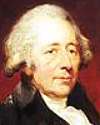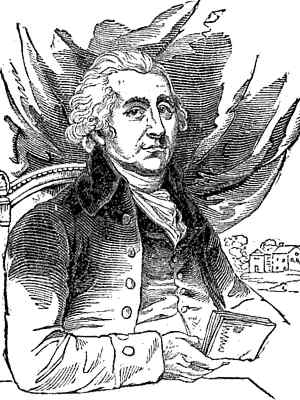 (source)
(source)
|
Matthew Boulton
(3 Sep 1728 - 17 Aug 1809)
British engineer and manufacturer who financed and introduced James Watt's steam engine.
|
Memoir of Matthew Boulton, Esq.
from Mechanic’s Magazine (1826)
[p.249] Matthew Boulton, a manufacturer and practical engineer of great celebrity, son of Matthew Boulton, by his wife Christian, daughter of Mr. Peers, of Chester, was born at Birmingham, the 14th of September, 1728, and died in August, 1809.
He was educated at a neighbouring grammar school, kept by Mr. Ansted, of Deritend, and was called into active life upon the death of his father, in 1745. The various processes by which the powers of the human mind give facility to the artist in rendering the different forms of matter obedient to his command, afforded ample scope for the exercise of his inventive faculties, in improving the manufactures of his native place. His first attempt was a new mode of inlaying steel; and he succeeded in obtaining a considerable demand for the products of his manufactory, which were principally exported to the Continent, and not uncommonly reimported for domestic use, as of foreign manufacture.
In 1762, his fortune being already considerable, he purchased a tract of barren heath, in the neighbourhood of Birmingham, with a single house on it, and there founded, at the expense of 9000l. the manufactory which has been so flourishing, and so well known under the name of Soho. His workmen were at first principally employed in the imitation of or-moulu, and in copying oil paintings with great accuracy, by means of a mechanical process which was invented by a Mr. Egginton, who afterwards distinguished himself by various works in stained glass. Mr. Boulton, finding the force of horses inadequate to the various purposes of his machinery, erected, in 1767, a steam engine, upon the original construction of Savery, which, notwithstanding the inconvenience of a great loss of steam from [p.250] condensation, by its immediate contract with the water raised, has still some advantages from the simplicity of the apparatus which it requires, and has even lately been found to succeed well upon a small scale. But Mr. Boulton's objects required a still more powerful machine, and he had the discernment to perceive that they might be very completely attained by the adoption of the various improvements lately made in the steam-engine by Mr. Watt, of Glasgow, who had obtained a patent for them in 1769, the privileges of which were extended, in 1775, by an act of parliament, to a term of 25 years. Mr. Boulton induced this ingenious and scientific inventor to remove to Birmingham.
They commenced a partnership in business, and established a manufactory of steam-engines, in which, accurate execution kept pace so well with judicious design, that its productions continued to be equally in request with the public, after the expiration of the term of that legal privilege, which, at first, gave the proprietors the exclusive right of supplying them; and which had been confirmed, in 1798, by a decision of the court of King's Bench, against some encroachments on the right of the patentee, it was principally for the purpose of carrying on this manufactory with greater convenience, that the proprietors established an iron foundry of their own, at Smethwick, in the neighbourhood of Soho.
In 1785, Mr. Boulton was made a fellow of the Royal Society, about the same time with Dr. Withering, and several others of his scientific neighbours. In 1788 he turned his attention to the subject of coining, and erected machinery for the purpose, so extensive and so complete, that the operation was performed with equal economy and precision; and the coins could not be imitated by any single artist for their nominal value; each of the stamps coining, with the attendance of a little boy only, about eighty pieces in a minute. The preparatory operation of laminating and cutting out the metal, is performed in an adjoining room; and all personal communication between the workmen employed is rendered unnecessary, by the mechanical conveyance of the work from one part of the machinery to another. A coinage of silver was executed at this mint, for the Sierra Leone Company, and another of copper for the East Indies, besides the pence and halfpence at present in circulation throughout England, and a large quantity of money of all kinds for Russia. In acknowledgement of Mr. Boulton's services, and in return for some specimens of his different manufactures, the emperor Paul, made him a present of a valuable collection of medals and of minerals.
Mr. Boulton obtained, in 1797, a patent for a mode of raising water by impulse, the specification of which, is published in the ninth volume of the Repertory of Arts, p. 145. It had been demonstrated by Daniel Bernoulli, in the beginning of the last century, that water flowing through a pipe, and arriving at a part in which the pipe is suddenly contracted, would have its velocity, at first, very greatly increased; but no practical application of the principle appears to have been attempted, until an apparatus was set up, in 1792, by Mr. Whitehurst, for Mr. Egerton, of Oulton, in Cheshire; consisting of an air-vessel, communicating with a water-pipe by a valve, which was forced open by the pressure or rather impulse of the water, when its passage through the pipe was suddenly stopped by turning the cock, in the ordinary course of domestic economy; and although the pipe, through which the water was forced up, was of moderate height, the air-vessel, which was at first made of lead, was soon burst by the "momentous force," as Mr. Whitehouse very properly terms it. The apparatus had excited much attention in France, under the name of Montgolfier's Hydraulic Ram, and Mr. Boulton added to it a number of ingenious modifications; some of which, however, are more calculated to display the vivid imagination of a projector, than the sound judgment of a practical engineer, which had, [p.251] in general, so strongly characterized all his productions.
He died, after a long illness, in possession of considerable affluence, and universal esteem, leaving a son and daughter to profit by the wealth and respectability which he had acquired. He was buried on the 24th of August, at Handsworth, near Soho, attended by a procession of 600 workmen, and by a numerous train of his friends and acquaintance. —Monthly Magazine, Oct. 1809, p. 368.
- Science Quotes by Matthew Boulton.
- 3 Sep - short biography, births, deaths and events on date of Boulton's birth.
- Matthew Boulton: Obituary - from The Monthly Magazine (1 Oct 1809).





